Homage to “The World’s Greenest Commercial Building” – Pt 2 of 2

Continuing yesterday’s post about the Bullitt Center (Pt 1), I’ll recopy the Living Building Challenge Imperatives summary that are relevant to today’s post:
- Energy: A solar array generates as much electricity as the building uses (actually 60% more than we used in 2014).
- Health: The building promotes health for its occupants, with inviting stairways, operable windows and features to promote walking and resource sharing.
- Equity: All workstations are within 30 feet of large operable windows, offering workers access to fresh air and natural daylight.
- Beauty: Stunning architecture, an innovative photovoltaic array, a green roof and other native plantings, large structural timbers and a revitalized pocket park help beautify the surrounding neighborhood.
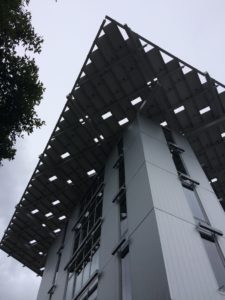
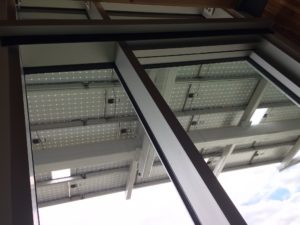 Energy: What I prefer to call the solar sombrero (canopy) is stunning. In the first pix above you may glean how far over the sidewalk it projects. That’s to get enough kWs to make the building self-sufficient as to power consumption.
Energy: What I prefer to call the solar sombrero (canopy) is stunning. In the first pix above you may glean how far over the sidewalk it projects. That’s to get enough kWs to make the building self-sufficient as to power consumption.
For Bullitt Center, the solar canopy is likened to a tree canopy. Why not?
A trend in the most progressive states is to encourage new building and renovation designs to achieve “net zero” energy consumption. One means is by employing roof-top solar PV arrays. But, if Bullitt Center is an example of what’s needed, can you imagine a bunch of buildings with solar sombreros? The taller the building the broader the canopy? Well, exterior glass is currently being made that includes solar power collection/distribution so we’ll see what the future holds.
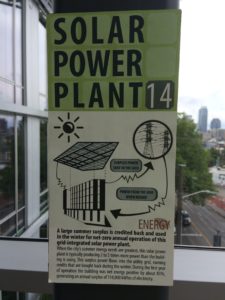 This solar power plant sign indicates there’s a sizable summer surplus–2 to 5x the need–credited back for use during the gray days; particularly in the winters. Important for unknowing visitors is info noting this “solar power plant” is grid-integrated.
This solar power plant sign indicates there’s a sizable summer surplus–2 to 5x the need–credited back for use during the gray days; particularly in the winters. Important for unknowing visitors is info noting this “solar power plant” is grid-integrated.
In its first year of ops, Bullitt Center was net energy positive by about 114k kWh, or 83%. Hey, if you haven’t already talked with Solar City, or Solar Energy Services if living/working in the DC/Baltimore metro areas, about adding a solar PV array to your home, or the back 40 (or your business building roof) what are you waiting for? It’d be a major reduction in your casa’s carbon footprint.
Another power source for what’s called thermal comfort is the building’s ground source heat pump aka sustainable geothermal energy. At Bullitt, there are 26 wells driven 400 feet below the building. (For discussion about how geothermal energy is harnessed, look here.)
Geothermally warmed air is then transferred around the building by hydronic radiant tubing which lays just a few inches beneath the concrete flooring surface. Radiant heating has been around for a long time. But, it’s use started to fade after inefficient baseboard heating was developed at a lower installation cost.
Radiant heating is more efficient than forced-air heating too as heat transmission loss through the linear footage of ducting is eliminated. It also avoids broadcasting allergens from vents arrayed around interior spaces, a source of trouble for allergy sufferers (much less a rare episode of Legionnaire’s disease).
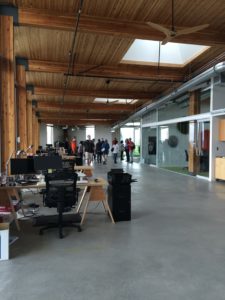
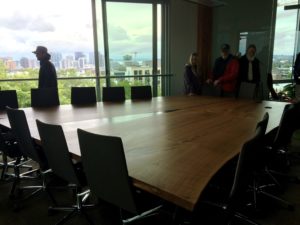 Health and Equity: All occupiable spaces at the core of the building have lots of natural daylight and views through the perimeter windows.
Health and Equity: All occupiable spaces at the core of the building have lots of natural daylight and views through the perimeter windows.
But, this last is one of my favorites. It can be found, somewhere, in most commercial buildings, and of late has been made a “feature” of green ones.
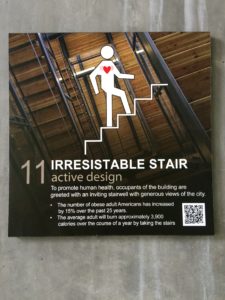 For its impact on interior design and human health, I always look for the stairs. And, I take them often.
For its impact on interior design and human health, I always look for the stairs. And, I take them often.
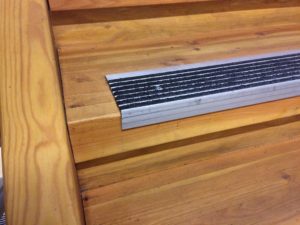 “Irresistable Stair,” Bullitt Center’s graphic for this sustainable building component, is one of the most appealing I’ve seen (even allowing for the misspelling).
“Irresistable Stair,” Bullitt Center’s graphic for this sustainable building component, is one of the most appealing I’ve seen (even allowing for the misspelling).
If you scan the bar code with your phone, here’s where you’ll wind up–and what you’ll learn.
Also, what my pix of the stair tread would have you know is whatever you bring in on the bottom of your shoes that would make the interior spaces dustier/dirtier is likely to be left in these stair tread mats.
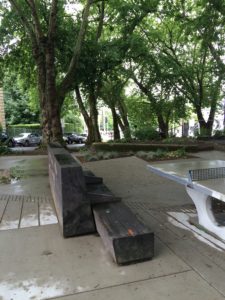 Beauty: The revitalized pocket park is the site of year-round ping-pong games along with a permanent bench for resting, or watching birds flying in and around the tree canopy. Or, listening to them. This pocket park is simply delightful! An oasis. Or, as urban pocket parks usually are, a relief.
Beauty: The revitalized pocket park is the site of year-round ping-pong games along with a permanent bench for resting, or watching birds flying in and around the tree canopy. Or, listening to them. This pocket park is simply delightful! An oasis. Or, as urban pocket parks usually are, a relief.
Large structural timbers can be seen throughout, another contributor to Beauty.
For you building designers, particularly, I recommend seeing the building dashboard video made to describe the building process. In it you’ll find Seattle Planning and Development Director Diane Sugimura saying:
“Our codes weren’t developed to build a living building.”
•
Note that Bullitt Foundation president Denis Hayes was recruited in 1969 by Earth Day’s brainchild, Sen. Gaylord Nelson, to be the National Coordinator of the “national teach-in on the environment” day.
♣♦♥♠